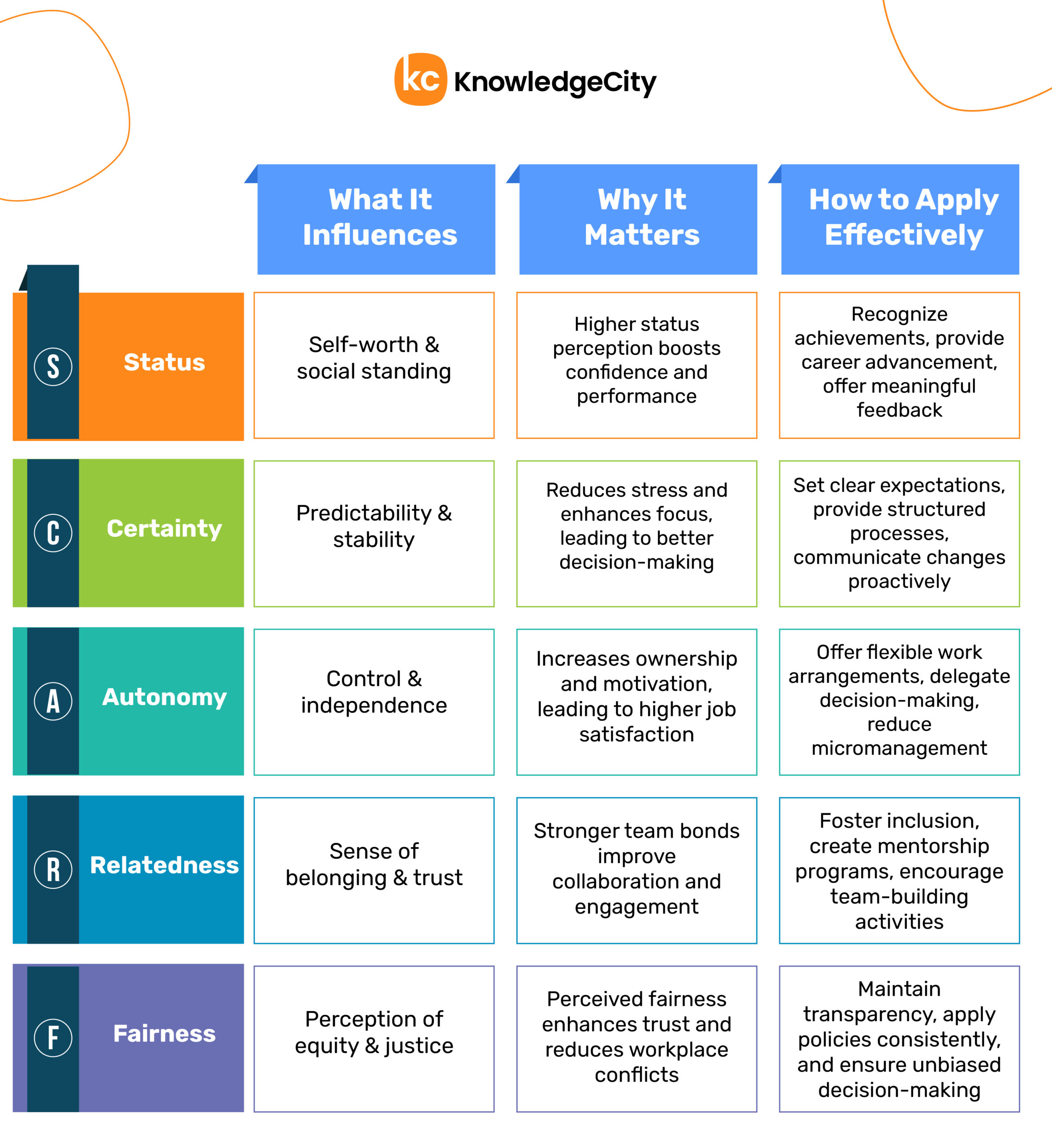Collaboration goes beyond working together. It’s about creating an environment where people feel safe, valued, and motivated to share their best ideas. Yet many organizations struggle with real teamwork because they focus too much on processes and tools while overlooking a critical factor: human psychology.
The SCARF model, developed by neuroscientist David Rock, offers a research-backed approach to improving workplace collaboration. It focuses on five core social drivers that influence behavior: Status, Certainty, Autonomy, Relatedness, and Fairness. When these needs are met, teams build stronger trust, show more cooperation, and generate better ideas. When they are neglected, collaboration becomes strained and conflict is more likely.
Technology and structural changes can support teamwork, but they don’t create it. True collaboration happens when employees develop essential skills like collaborative communication, active listening, and conflict resolution. These skills align closely with the principles of the SCARF model. By applying SCARF in everyday team interactions, organizations can lower resistance, build stronger cross-functional relationships, and create a workplace where collaboration happens naturally.

How to Apply Each SCARF Principle
Understanding and implementing SCARF principles can enhance workplace motivation, collaboration, and performance. Let’s explore each principle and how to apply it for long-term success and a positive organizational culture.

Why It Matters
People are wired to seek recognition and respect. In traditional workplaces, status is tied to job titles, leading to power imbalances and hesitation to speak up. This stifles collaboration, as employees may feel reluctant to challenge ideas, share insights, or take initiative in group settings.
How to Apply It
To foster collaboration, shift from hierarchical status (based on authority) to contribution-based status (based on impact).
- Make Expertise Visible: Train employees on peer recognition practices where contributions, not job titles, determine influence. Use real-time recognition tools like Kudos boards or internal leaderboards.
- Redesign Meetings for Inclusivity: Equip employees with facilitation techniques that ensure all voices are heard before leaders weigh in. Round-robin discussions and anonymous idea submissions help break down status barriers.
- Adopt a “Lead-by-Expertise” Model: Assign project leadership based on subject-matter expertise rather than hierarchy. Training in collaborative leadership ensures that employees are prepared to take on these roles effectively.
Investing in soft skills training helps organizations foster a culture where expertise drives impact. Choose KnowledgeCity, the best employee training platform in the USA, to equip your workforce with the skills to break silos, increase productivity, and drive innovation.
Why It Matters
Uncertainty triggers stress. When employees lack clear expectations around goals, roles, or processes, they often become defensive, territorial, or disengaged. These reactions can quietly erode collaboration.
How to Apply It
Organizations need predictable structures that eliminate confusion and foster seamless teamwork.
- Standardize Decision-Making: Implement a DACI (Driver, Approver, Contributor, Informed) framework so employees understand their roles in cross-team decisions. Provide training on collaborative decision-making to ensure teams apply this effectively.
- Use Collaboration Charters: Define how teams should communicate (e.g., Slack for quick questions, email for formal approvals, meetings for brainstorming). Make sure employees are familiar with best practices for digital communication to prevent misalignment.
- Increase Transparency with Project Visibility: Train teams on asynchronous collaboration strategies using tools like Notion, ClickUp, or Asana to create a shared source of truth for all projects.
Certainty gives teams clarity. When people know what to expect, they communicate more confidently and collaborate with less friction.
Why It Matters
People collaborate best when they feel a sense of ownership over their work. However, too many approvals, micromanagement, or rigid processes kill creativity and reduce initiative, causing employees to resist teamwork.
How to Apply It
Organizations must balance structure and flexibility by allowing employees to make decisions within clear boundaries.
- Outcome-Based Goals Over Task-Based Instructions: Train managers to focus on what success looks like instead of dictating how tasks should be completed. This encourages innovation while maintaining alignment.
- Empower Employees with Guardrails: Instead of excessive approvals, set up collaborative decision-making workshops to teach employees how to make high-impact choices within their scope of work.
- Flexible Work Styles for Better Team Flow: Train employees on synchronous vs. asynchronous collaboration, allowing teams to decide whether they need daily standups or async updates based on project needs.
Autonomy builds engagement. When employees feel trusted, they actively drive collaboration.
Why It Matters
People naturally collaborate with those they trust. However, remote work, siloed departments, and a lack of relationship-building weaken trust and reduce open communication.
How to Apply It
To build stronger connections, organizations need deliberate trust-building strategies.
- Cross-Team Shadowing: Let employees work with different teams for a day to increase empathy and understanding. Training employees in cross-functional teamwork makes these experiences more effective.
- Psychological Safety Training: Teach employees how to receive and give constructive feedback without fear of judgment. Blameless post-mortems and open-forum discussions help reinforce this mindset.
- AI-Powered Networking: Use AI-driven internal tools to match employees for virtual coffee chats based on shared interests and collaboration history.
- “No Agenda” Meetings: Foster open dialogue sessions where employees discuss challenges freely without pressure to produce immediate solutions. Training in facilitated dialogue techniques ensures these meetings remain productive.
Stronger relationships lead to better collaboration. Trust allows teams to move beyond basic cooperation and work together to create real value.
Why It Matters
Perceived unfairness leads to resentment, disengagement, and passive resistance. These reactions quietly disrupt collaboration. When employees feel that decision-making, credit-sharing, or opportunities are biased, they tend to pull back rather than participate.
How to Apply It
To create a truly fair collaboration culture, organizations must ensure equal access to information, credit, and opportunities.
- Rotate Leadership Roles: Prevent the same voices from always leading by training employees in facilitation skills and rotating project leadership.
- Transparent Knowledge-Sharing: Implement open-access knowledge management systems and train employees on effective knowledge-sharing practices.
- Recognition Based on Contribution: Create collaborative performance metrics that highlight team impact rather than individual achievements.
Fairness builds commitment. When people feel valued and included, they’re more likely to contribute with energy and purpose.
The SCARF model provides a strong framework for improving workplace collaboration. However, without proper training, even the best frameworks can fail. Employees need more than guidelines; they require practical skills in communication, conflict resolution, and teamwork to make collaboration work effectively.
Why KnowledgeCity Is the Best Employee Training Platform in the USA
With over 18 years of proven expertise, KnowledgeCity is the best employee training platform in the USA, trusted by organizations such as Spartonics, TKC Holdings, and Baker’s Burgers to accelerate employee growth, ensure compliance, and streamline workforce development.
Our platform delivers accredited certifications, is available in multiple languages, and features a fully customizable LMS. Combined with mobile accessibility, advanced analytics, and seamless HR system integration, KnowledgeCity empowers organizations to provide effective, measurable training that aligns with their strategic objectives and drives lasting impact.
See how our platform can help your teams collaborate with confidence, adapt to challenges, and deliver measurable results.
Subscribe to Our Newsletter
Join 80,000+ Fellow HR Professionals. Get expert recruiting and training tips straight
to your inbox, and become a better HR manager.





 KnowledgeCity
KnowledgeCity 












